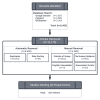A systematic review of extended reality (XR) for understanding and augmenting vision loss
- PMID: 37140911
- PMCID: PMC10166121
- DOI: 10.1167/jov.23.5.5
A systematic review of extended reality (XR) for understanding and augmenting vision loss
Abstract
Over the past decade, extended reality (XR) has emerged as an assistive technology not only to augment residual vision of people losing their sight but also to study the rudimentary vision restored to blind people by a visual neuroprosthesis. A defining quality of these XR technologies is their ability to update the stimulus based on the user's eye, head, or body movements. To make the best use of these emerging technologies, it is valuable and timely to understand the state of this research and identify any shortcomings that are present. Here we present a systematic literature review of 227 publications from 106 different venues assessing the potential of XR technology to further visual accessibility. In contrast to other reviews, we sample studies from multiple scientific disciplines, focus on technology that augments a person's residual vision, and require studies to feature a quantitative evaluation with appropriate end users. We summarize prominent findings from different XR research areas, show how the landscape has changed over the past decade, and identify scientific gaps in the literature. Specifically, we highlight the need for real-world validation, the broadening of end-user participation, and a more nuanced understanding of the usability of different XR-based accessibility aids.
Figures






Similar articles
-
Mobile assistive technologies for the visually impaired.Surv Ophthalmol. 2013 Nov-Dec;58(6):513-28. doi: 10.1016/j.survophthal.2012.10.004. Epub 2013 Sep 20. Surv Ophthalmol. 2013. PMID: 24054999 Review.
-
Expounding the rehabilitation service for acquired visual impairment contingent on assistive technology acceptance.Disabil Rehabil Assist Technol. 2021 Jul;16(5):520-524. doi: 10.1080/17483107.2019.1683238. Epub 2020 May 4. Disabil Rehabil Assist Technol. 2021. PMID: 32363954
-
The future of Cochrane Neonatal.Early Hum Dev. 2020 Nov;150:105191. doi: 10.1016/j.earlhumdev.2020.105191. Epub 2020 Sep 12. Early Hum Dev. 2020. PMID: 33036834
-
Blindness and vision impairment in the elderly of Papua New Guinea.Clin Exp Ophthalmol. 2006 May-Jun;34(4):335-41. doi: 10.1111/j.1442-9071.2006.01219.x. Clin Exp Ophthalmol. 2006. PMID: 16764653
-
Assistive device using computer vision and image processing for visually impaired; review and current status.Disabil Rehabil Assist Technol. 2022 Apr;17(3):290-297. doi: 10.1080/17483107.2020.1786731. Epub 2020 Jul 1. Disabil Rehabil Assist Technol. 2022. PMID: 32608288 Review.
Cited by
-
Aligning visual prosthetic development with implantee needs.medRxiv [Preprint]. 2024 Oct 28:2024.03.12.24304186. doi: 10.1101/2024.03.12.24304186. medRxiv. 2024. Update in: Transl Vis Sci Technol. 2024 Nov 4;13(11):28. doi: 10.1167/tvst.13.11.28. PMID: 38559196 Free PMC article. Updated. Preprint.
-
Towards aSmart Bionic Eye: AI-powered artificial vision for the treatment of incurable blindness.J Neural Eng. 2022 Dec 7;19(6):10.1088/1741-2552/aca69d. doi: 10.1088/1741-2552/aca69d. J Neural Eng. 2022. PMID: 36541463 Free PMC article.
-
Aligning Visual Prosthetic Development With Implantee Needs.Transl Vis Sci Technol. 2024 Nov 4;13(11):28. doi: 10.1167/tvst.13.11.28. Transl Vis Sci Technol. 2024. PMID: 39570616 Free PMC article.
-
Assistive technology use in domestic activities by people who are blind.Sci Rep. 2025 Mar 3;15(1):7486. doi: 10.1038/s41598-025-91755-w. Sci Rep. 2025. PMID: 40032957 Free PMC article.
-
Simulated prosthetic vision confirms checkerboard as an effective raster pattern for epiretinal implants.J Neural Eng. 2025 Jul 16;22(4):046017. doi: 10.1088/1741-2552/adecc4. J Neural Eng. 2025. PMID: 40623420 Free PMC article.
References
-
- Addleman, D. A., Legge, G. E., & Jiang, Y. (2021). Simulated central vision loss impairs implicit location probability learning. Cortex, 138, 241–252. - PubMed
-
- Ahmetovic, D., Guerreiro, J., Ohn-Bar, E., Kitani, K. M., & Asakawa, C. (2019). Impact of expertise on interaction preferences for navigation assistance of visually impaired in dividuals. In Proceedings of the 16th International Web for All Conference, W4A ’19 (pp. 1–9). New York, NY: Association for Computing Machinery.

